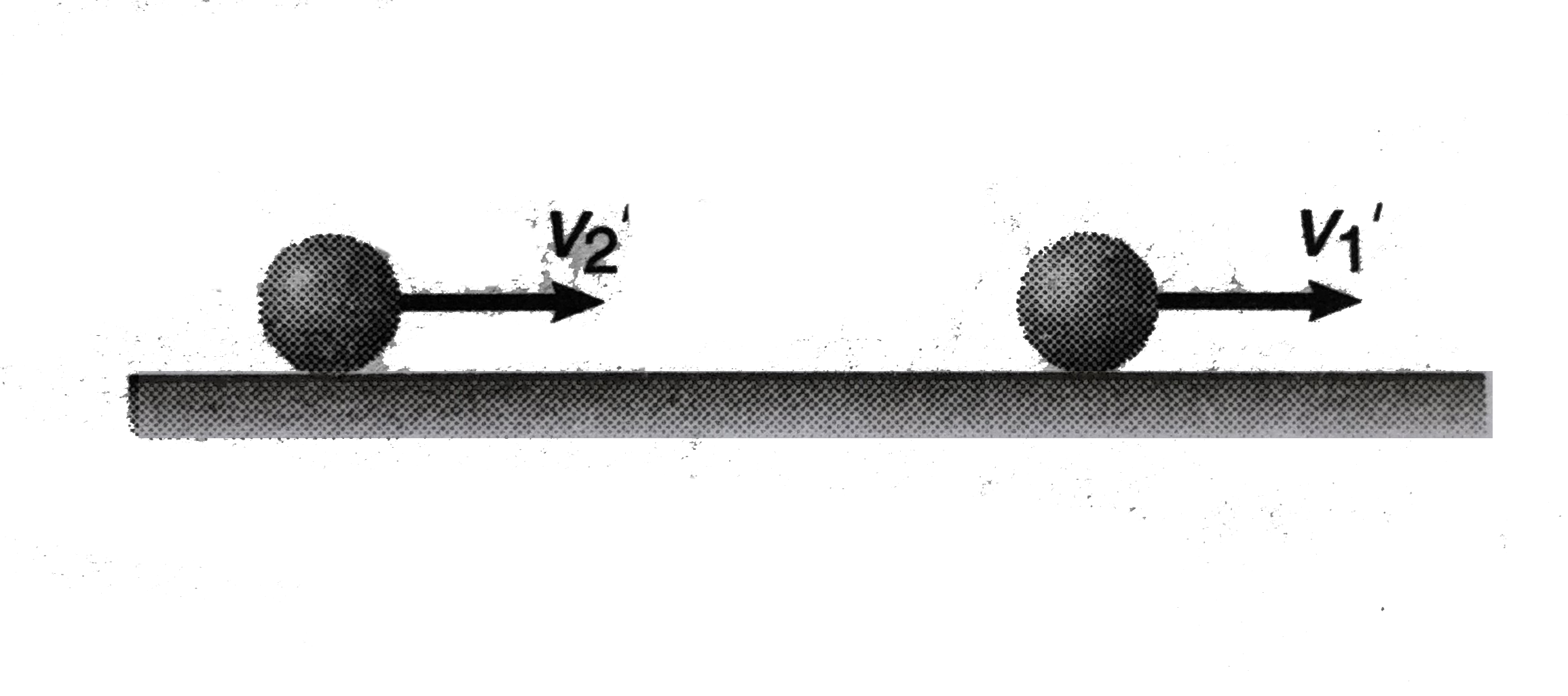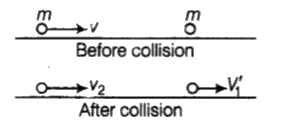A ball of 4kg mass moving with a speed of 3ms−1 has a head on elastic collision with a 6kg mass initially at rest. The speeds of both the bodies after collision are respectively
0.6ms−1,2.4ms−1
−0.6ms−1,−2.4ms−1
−0.6ms−1,2.4ms−1
−0.6ms−1,−2.4ms−1
The correct Answer is:C
To solve the problem of an elastic collision between a 4 kg ball moving at 3 m/s and a 6 kg ball initially at rest, we will use the principles of conservation of momentum and the properties of elastic collisions.
1. Identify the Given Values:
- Mass of ball 1 (m1) = 4 kg
- Initial velocity of ball 1 (u1) = 3 m/s
- Mass of ball 2 (m2) = 6 kg
- Initial velocity of ball 2 (u2) = 0 m/s (since it is at rest)
2. Conservation of Momentum:
The total momentum before the collision is equal to the total momentum after the collision.
m1u1+m2u2=m1v1+m2v2
Substituting the known values:
4×3+6×0=4v1+6v2
This simplifies to:
12=4v1+6v2(Equation 1)
3. Elastic Collision Condition:
For an elastic collision, the relative velocity of separation is equal to the relative velocity of approach.
v2−v1=u1−u2
Substituting the known values:
v2−v1=3−0
This simplifies to:
v2−v1=3(Equation 2)
4. Solve Equations Simultaneously:
From Equation 2, we can express v2 in terms of v1:
v2=v1+3
Now substitute v2 in Equation 1:
12=4v1+6(v1+3)
Expanding this gives:
12=4v1+6v1+18
Combining like terms:
12=10v1+18
Rearranging gives:
10v1=12−18
10v1=−6
v1=−0.6m/s
5. Find v2:
Now substitute v1 back into the equation for v2:
v2=−0.6+3=2.4m/s
Final Answer:
- The speed of the 4 kg ball after the collision (v1) is -0.6 m/s (indicating it moves in the opposite direction).
- The speed of the 6 kg ball after the collision (v2) is 2.4 m/s.
- Mass of ball 1 (m1) = 4 kg
- Initial velocity of ball 1 (u1) = 3 m/s
- Mass of ball 2 (m2) = 6 kg
- Initial velocity of ball 2 (u2) = 0 m/s (since it is at rest)
The total momentum before the collision is equal to the total momentum after the collision.
m1u1+m2u2=m1v1+m2v2
Substituting the known values:
4×3+6×0=4v1+6v2
This simplifies to:
12=4v1+6v2(Equation 1)
For an elastic collision, the relative velocity of separation is equal to the relative velocity of approach.
v2−v1=u1−u2
Substituting the known values:
v2−v1=3−0
This simplifies to:
v2−v1=3(Equation 2)
From Equation 2, we can express v2 in terms of v1:
v2=v1+3
12=4v1+6(v1+3)
Expanding this gives:
12=4v1+6v1+18
Combining like terms:
12=10v1+18
Rearranging gives:
10v1=12−18
10v1=−6
v1=−0.6m/s
Now substitute v1 back into the equation for v2:
v2=−0.6+3=2.4m/s
- The speed of the 4 kg ball after the collision (v1) is -0.6 m/s (indicating it moves in the opposite direction).
- The speed of the 6 kg ball after the collision (v2) is 2.4 m/s.
Topper's Solved these Questions
- BOOK - NARAYNACHAPTER - COLLISIONEXERCISE - Level-II (H.W)54videos
COLLISION
- BOOK - NARAYNACHAPTER - COLLISIONEXERCISE - Subjective type Questions9videos
COLLISION
- BOOK - NARAYNACHAPTER - CIRCULAR MOTIONEXERCISE - LEVEL II(H.W)51videos
CIRCULAR MOTION
- BOOK - NARAYNACHAPTER - FRICTIONEXERCISE - Passage type of questions I6videos
FRICTION
Similar Questions
A ball of mass m moving at a speed v makes a head on inelastic collision with an identical ball at rest. The kinetic energy of the balls after the collision is 34th of the original. Find the coefficient of restitution.

 View Solution
View SolutionOn a frictionless surface, a ball of mass m moving at a speed v makes a head on collision with an identical ball at rest. The kinetic energy of the balls after the collision is 3/4th of the original. Find the coefficient of restitution.
View Solution
Knowledge Check
- Question 1 - Select One
A body of mass M moving with a speed u has a ‘head on’, perfectly elastic collision with a body of mass m initially at rest. If M>>m , the speed of the body of mass m after collision, will be nearly :
Aum/MBuM/mCu/2D2u - Question 2 - Select One
A ball of mass 'm' moving with speed 'u' undergoes a head-on elastic collision with a ball of mass 'nm' initially at rest. Find the fraction of the incident energy transferred to the second ball.
An1+nBn(1+n)2C2n(1+n)2D4n(1+n)2 - Question 3 - Select One
A ball of mass 'm' moving with speed 'u' undergoes a head-on elastic collision with a ball of mass 'nm' initially at rest. Find the fraction of the incident energy transferred to the second ball.
Ann+1Bn(n+1)2C2n(1+n)2D4n(1+n)2
A ball of mass m moving at speed v makes a head on collision with an identical ball at rest. The kinetic energy of the balls after the collision is 3/4th of the original. Find the coefficient of restitution.
View SolutionA ball of mass m moving with a speed v makes a head on collision with an identical ball at rest. The kinetic energy after collision of the balls is three fourth of the original kinetic energy. The coefficient of restitution is
View SolutionA particle P moving with speed v undergoes a head -on elastic collision with another particle Q of identical mass but at rest. After the collision the collision
View SolutionChoose the most appropriate option.
A ball of mass m moving at a speed v makes a head on collision with an identical ball at rest. The kinetic energy at the balls after the collision is 3/4th of the original. What is the coefficient of restitution?
 View Solution
View SolutionA block of mass 1kg moving with a speed of 4ms−1, collides with another block of mass 2kg which is at rest. If the lighter block comes to rest after collision, then the speed of the heavier body is
View Solution

